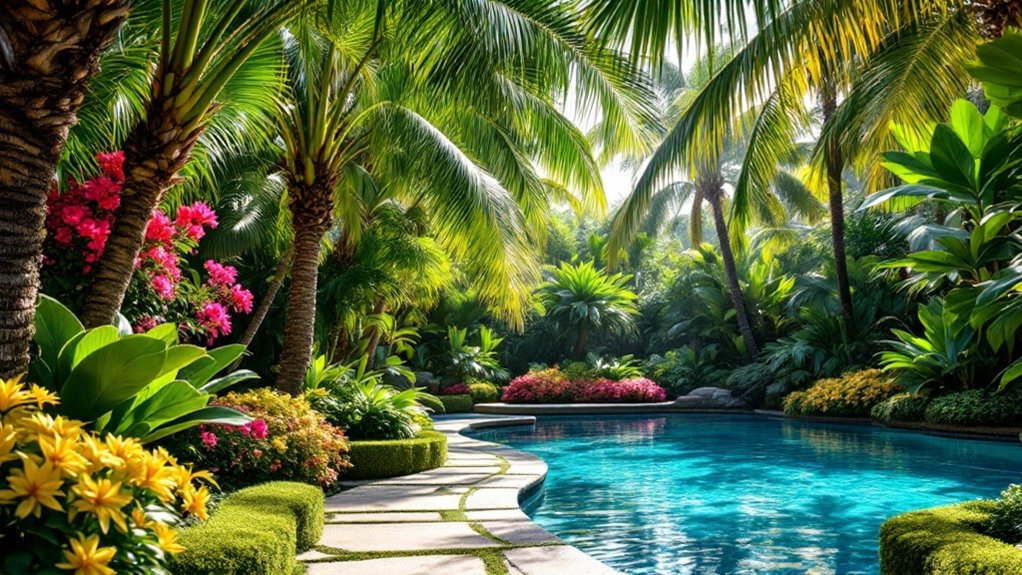Green landscaping plays an essential role in transforming a pool area into an inviting retreat. The combination of vibrant plants and flowers creates a striking contrast against the clear water. This not only enhances the visual appeal but also introduces benefits such as improved privacy and reduced water evaporation. As the seasons change, the landscape offers varying beauty. Understanding the elements that contribute to this transformation is important for anyone considering an upgrade to their outdoor space.
The Aesthetic Appeal of Greenery
While many homeowners focus on the pool’s design, the surrounding greenery plays an equally important role in enhancing the overall aesthetic appeal. Lush plants, vibrant flowers, and carefully placed trees create a harmonious environment that invites relaxation. The contrast between the shimmering water and rich foliage can transform a simple pool area into a tranquil oasis. Strategic landscaping can provide privacy, frame the pool beautifully, and even soften hardscapes. Additionally, native plants can attract local wildlife, adding dynamic life to the space. Incorporating various textures and colors through greenery not only enhances visual interest but also creates a welcoming atmosphere. Ultimately, thoughtful landscaping complements the pool, making it a focal point of enjoyment for family and guests alike.
Creating a Tropical Vibe
To enhance the serene atmosphere of a pool area, creating a tropical vibe can transport homeowners and their guests to a sun-soaked paradise. This can be achieved through the careful selection of vibrant plants, such as palm trees, hibiscus, and ferns, which evoke the essence of tropical destinations. Incorporating lush greenery around the pool not only adds color but also creates a sense of seclusion and relaxation. Adding decorative elements like bamboo fencing or thatched umbrellas can further enhance the tropical aesthetic. Using natural stone or sandy pathways can connect the pool area with the surrounding landscape, creating a seamless flow. Ultimately, a well-executed tropical vibe transforms a simple pool area into a luxurious retreat, inviting leisure and enjoyment.
Enhancing Privacy With Strategic Planting
When homeowners seek to create a more secluded atmosphere around their pool area, strategic planting can play an essential role in enhancing privacy. By selecting the right combination of trees, shrubs, and tall grasses, individuals can effectively shield their outdoor space from prying eyes. Dense evergreens, for instance, provide year-round coverage, while flowering shrubs can add aesthetic appeal alongside their privacy benefits. Additionally, planting a mix of heights and textures creates a natural barrier that softens the overall landscape. Climbing plants on trellises or fences can further enhance the secluded feel, allowing for an intimate and inviting environment. Thoughtful placement of these plants not only boosts privacy but also complements the overall design of the pool area, fostering a tranquil oasis.
Reducing Pool Water Evaporation
Creating a private retreat around a pool area is just one aspect of enhancing the overall outdoor experience. Green landscaping plays an essential role in reducing pool water evaporation, which can greatly lower maintenance costs and conserve water. Strategically placed trees and shrubs provide shade, limiting direct sunlight exposure on the water’s surface. Additionally, incorporating plants with higher transpiration rates can create a microclimate that helps maintain humidity levels, further decreasing evaporation rates. Utilizing decorative features such as water-wise plants or ground cover can also reduce wind exposure, which is another culprit in water loss. By thoughtfully designing the landscape around the pool, homeowners can create an eco-friendly environment that enhances the aesthetic appeal while effectively minimizing water evaporation.
Improving Safety With Soft Landscaping
Soft landscaping plays an essential role in enhancing safety around pool areas. By incorporating materials that cushion falls, the risk of injury from slips and tumbles can be noticeably reduced. Additionally, careful selection of non-slippery surfaces helps prevent accidents, ensuring a safer environment for pool users.
Cushioning Falls Effectively
Incorporating soft landscaping around pool areas greatly enhances safety by cushioning potential falls. Grass, mulch, and soft ground cover act as natural barriers, reducing the risk of injury from accidental slips. These materials absorb impact better than hard surfaces, creating a safer environment for both children and adults. Additionally, the gentle texture of soft landscaping encourages more comfortable movement around the pool, promoting leisurely activities without the constant worry of falls. Strategically placed plants and shrubs can also serve as visual barriers, guiding users toward safe pathways. By prioritizing cushioning elements, pool owners can create a protective atmosphere that fosters enjoyment while minimizing hazards. This thoughtful approach to landscaping elevates both safety and aesthetic appeal in poolside environments.
Natural Slippery Surface Prevention
A well-designed pool area can greatly reduce the risk of slips and falls by implementing natural landscaping techniques. Incorporating soft landscaping elements, such as textured stones, rubber mulch, or natural grass, can create a more stable footing around the pool. These materials not only provide aesthetic appeal but also mitigate the dangers associated with slippery surfaces. Additionally, strategically placed plants can help absorb excess moisture, reducing the likelihood of slick areas. Incorporating drainage solutions, such as permeable paving or gravel, can further assist in managing water runoff. By prioritizing natural surface prevention methods, homeowners enhance both the safety and functionality of their pool environment, creating an inviting space for relaxation and recreation.
Choosing the Right Plants for Your Poolside
Selecting the right plants for a poolside area involves considering both native species and low-maintenance options. Native plants often thrive in local climates, requiring less water and care, while low-maintenance varieties reduce the workload for homeowners. This approach not only enhances the aesthetic appeal but also contributes to a sustainable landscaping solution.
Native Plant Selection
Choosing the right native plants for a poolside area enhances both aesthetics and functionality. Native plants are well-adapted to local climates, requiring less water and fertilizer, which is beneficial for maintaining a sustainable pool environment. These plants thrive in their natural surroundings, promoting biodiversity and creating habitats for local wildlife. Additionally, native species can help reduce erosion and improve soil stability around the pool area. When selecting plants, it is essential to take into account factors such as sunlight exposure, soil type, and the overall landscape design. Incorporating a variety of textures and colors from native plants can create a harmonious and inviting atmosphere, transforming the poolside into a lush oasis that complements the natural surroundings while ensuring resilience against local environmental conditions.
Low-Maintenance Options
Incorporating low-maintenance plants into a poolside landscape can greatly enhance the enjoyment and functionality of the space while minimizing upkeep. Selecting drought-resistant varieties, such as ornamental grasses and succulents, guarantees that the area remains vibrant without extensive watering. Additionally, perennials like daylilies and lavender offer colorful blooms and pleasant scents with minimal care. Groundcovers, such as creeping thyme, can effectively suppress weeds while adding texture. Choosing native plants also contributes to a sustainable environment, as they adapt well to local conditions and require less irrigation. By opting for these resilient plants, homeowners can create a beautiful, serene poolside oasis that allows for relaxation and enjoyment without the burden of rigorous maintenance.
Seasonal Interest: Year-Round Beauty
A vibrant pool area can transform a backyard into a stunning oasis, especially when seasonal interest is thoughtfully integrated into the landscaping design. To achieve year-round beauty, homeowners can select a combination of plants that showcase varied colors and textures throughout the seasons. For instance, spring flowers like tulips and daffodils can herald the warmer months, while summer blooms such as hydrangeas and daylilies provide lush greenery. In autumn, ornamental grasses and vibrant foliage create a warm ambiance, while winter evergreens add structure and color during the colder months. Incorporating seasonal interest not only enhances the aesthetic appeal but also creates a dynamic environment that invites enjoyment and relaxation, ensuring that the pool area remains enchanting all year long.
Maintenance Tips for a Lush Landscape
Maintaining a lush landscape around the pool area is key to preserving its vibrant appeal throughout the seasons. Regular watering is essential, especially during dry spells, to guarantee plants remain healthy and vibrant. Mulching around garden beds helps retain moisture and suppress weeds, reducing maintenance efforts. Pruning shrubs and trees promotes ideal growth and prevents overgrowth that can obstruct views or create debris. Fertilizing plants with appropriate nutrients enhances their health and color. Additionally, seasonal inspections for pests and diseases are important to maintaining plant vitality. Selecting native plants can further reduce maintenance needs, as they are typically more resilient and adapted to local conditions. These practices collectively contribute to a beautiful, inviting poolside landscape.
Frequently Asked Questions
How Can Landscaping Improve My Pool’s Resale Value?
Landscaping greatly enhances a pool’s resale value by creating an aesthetically pleasing environment. Thoughtful design, incorporating native plants and outdoor features, can attract potential buyers, making the property more desirable and increasing overall market appeal.
What Are the Best Times to Plant Around a Pool?
Determining the best times to plant around a pool depends on local climate. Generally, spring and early fall are ideal for planting, allowing plants to establish before winter and thrive during the warmer months.
Can Green Landscaping Attract Pests Near My Pool?
The concern regarding green landscaping attracting pests near a pool is valid. Certain plants can draw insects, while others may deter them. Strategic plant selection and maintenance are essential to minimize pest-related issues in outdoor spaces.
How Do I Prevent Pool Debris From Falling Into Plants?
To prevent pool debris from falling into plants, one can install barriers such as mesh nets, strategically place potted plants away from the pool’s edge, and regularly trim nearby trees to minimize leaf and branch drop.
Are There Eco-Friendly Landscaping Options for Pool Areas?
Eco-friendly landscaping options for pool areas include native plants, permeable paving, and organic mulches. These choices promote biodiversity, reduce water usage, and minimize chemical runoff, creating a sustainable environment that complements the pool’s aesthetic appeal.
Conclusion
To summarize, green landscaping greatly enriches pool areas by enhancing their aesthetic appeal, creating a tropical atmosphere, and providing essential privacy and safety. The strategic selection of plants not only reduces water evaporation but also guarantees year-round beauty with seasonal interest. With thoughtful maintenance, homeowners can transform their poolside into a serene retreat, offering a perfect blend of relaxation and enjoyment. Ultimately, embracing greenery around pools fosters a tranquil environment that is both visually stunning and eco-friendly.




